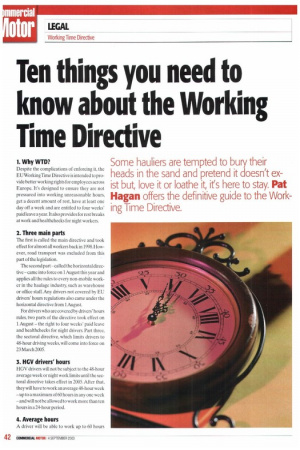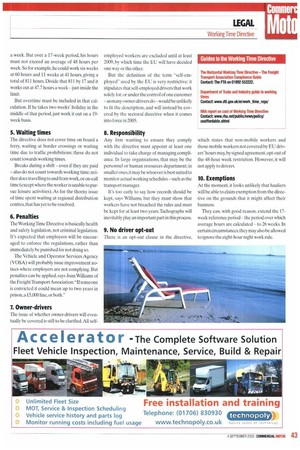Ten things you need to know about the Working Time Diredive
Page 42

Page 43

If you've noticed an error in this article please click here to report it so we can fix it.
Some hauliers are tempted to bury their heads in the sand and pretend it doesn't ex ist but, love it or loathe it, it's here to stay. Pat Hagan offers the definitive guide to the Work ing Time Directive.
1. Why WTD?
Despite the complications of enforcing it, the EUWorking Tune Directive is intended to provide better working rights for employees across Europe. It's designed to ensure they are not pressured into working unreasonable hours, get a decent amount of rest, have at least one day off a week and are entitled to four weeks' paid leave a year. It also provides for rest breaks at work and healthchecks for night workers.
2. Three main parts The first is called the main directive and took effect for almost all workers back in 1998. However, road transport was excluded from this part of the legislation.
The second part —called the horizontal directive — came into force on 1 August this year and applies all the rules to every non-mobile worker in the haulage industry, such as warehouse or office staff. Any drivers not covered by EU drivers' hours regulations also came under the horizontal directive from 1 August.
For drivers who are covered by drivers' hours rules, two parts of the directive took effect on 1 August — the right to four weeks' paid leave and healthchecks for night drivers. Part three, the sectoral directive, which limits drivers to 48-hour driving weeks, will come into force on 23 March 2005.
3. HGV drivers' hours HGV drivers will not be subject to the 48-hour average week or night work limits until the sectoral directive takes effect in 2005. After that, they will have to work an average 48-hour week — up to a maximum of 60 hours in any one week — and will not be allowed to work more than ten hours in a 24-hour period.
4. Average hours A driver will be able to work up to 60 hours a week. But over a 17-week period, his hours must not exceed an average of 48 hours per week. So for example, he could work six weeks at 60 hours and 11 weeks at 41 hours, giving a total of 811 hours. Divide that 811 by 17 and it works out at 47.7 hours a week just inside the limit.
But overtime must be included in that calculation. If he takes two weeks' holiday in the middle of that period, just work it out on a 19week basis.
5. Waiting times
The directive does not cover time on board a ferry, waiting at border crossings or waiting time due to traffic prohibitions; these do not count towards working times.
Breaks during a shift — even if they are paid — also do not count towards working time; neither does travelling to and from work, or on-call time (except where the worker is unable to pursue leisure activities). As for the thorny issue of time spent waiting at regional distribution centres, that has yet to be resolved.
6. Penalties
The WorkingTime Directive is basically health and safety legislation, not criminal legislation. It's expected that employers will be encouraged to enforce the regulations, rather than immediately be punished for not doing so.
The Vehicle and Operator Services Agency (VOSA) will probably issue improvement notices where employers are not complying. But penalties can be applied, says Joan Williams of the Freight Transport Association."If someone is convicted it could mean up to two years in prison, a £5,000 fine, or both."
7. Owner-drivers
The issue of whether owner-drivers will eventually be covered is still to be clarified. All self employed workers are excluded until at least 2009, by which time the EU will have decided one way or the other.
But the definition of the term "self-employedused by the EU is very restrictive: it stipulates that self-employed drivers that work solely for, or under the control of one customer — as many owner-drivers do — would be unlikely to tit the description, and will instead be covered by the sectoral directive when it comes into force in 2005.
8. Responsibility
Any Iirrn wanting to ensure they comply with the directive must appoint at least one individual to take charge of managing compliance. In large organisations, that may be the personnel or human resources department; in smaller ones, it may be whoever is best suited to monitor actual working schedules — such as the transport manager.
It's too early to say how records should be kept, says Williams, but they must show that workers have not breached the rules and must be kept for at least two years. Tachographs will inevitably play an important part in this process
9. No driver opt-out
There is an opt-out clause in the directive, which states that non-mobile workers and those mobile workers not covered by EU drivers' hours may, by signed agreement, opt-out of the 48-hour week restriction. However, it will not apply to drivers.
10. Exemptions
At the moment, it looks unlikely that hauliers will be able to claim exemption from the directive on the grounds that it might affect their business.
They can, with good reason, extend the 17week reference period — the period over which average hours are calculated — to 26 weeks. In certain circumstances, they may also be allowed to ignore the eight-hour night work rule.
















































































































































































































